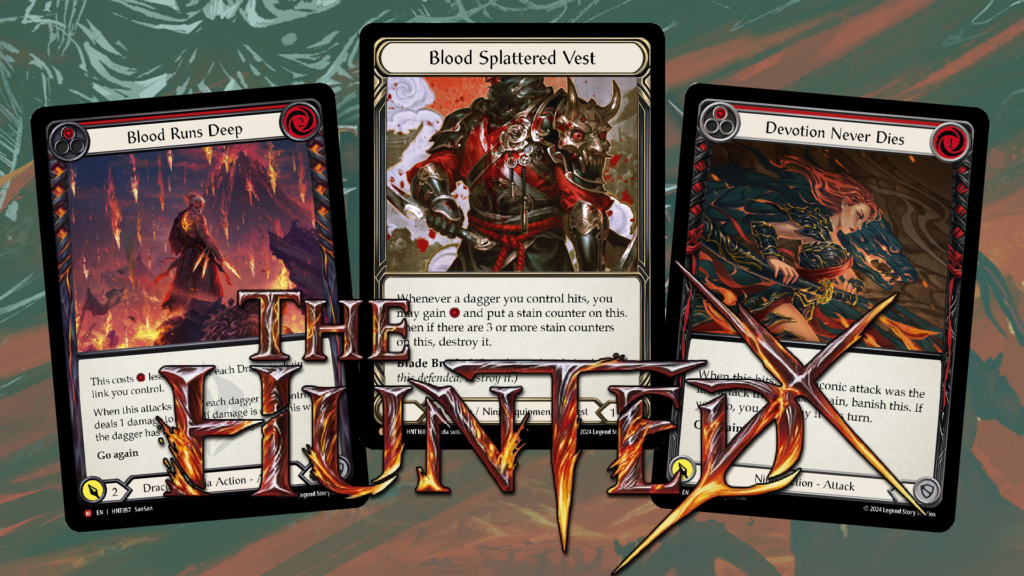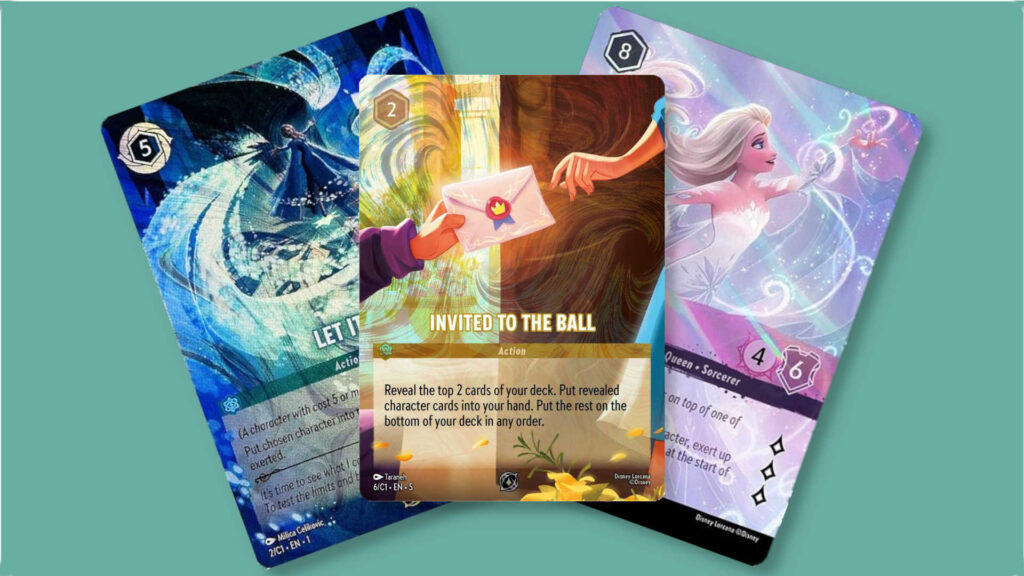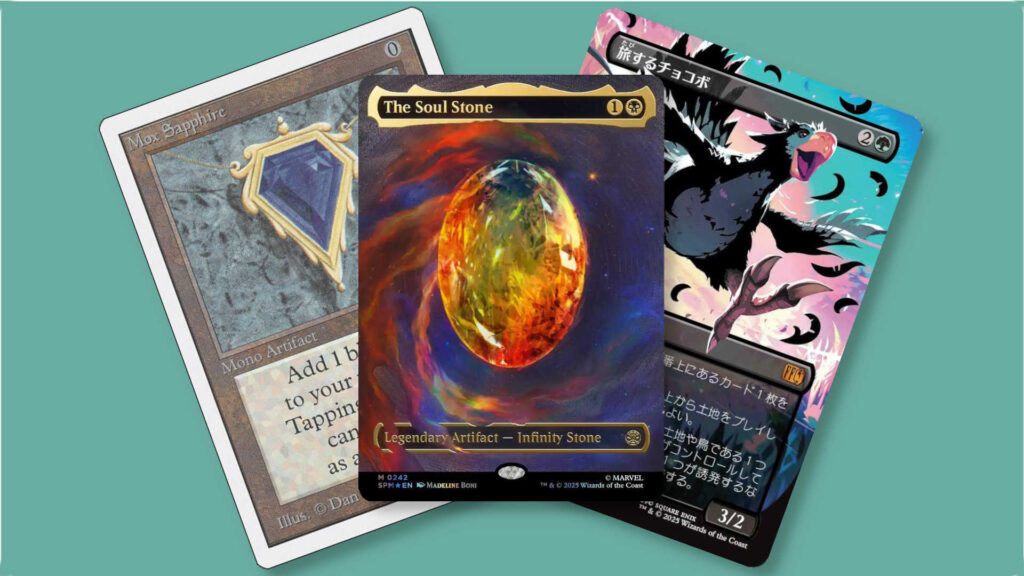All images courtesy of Legend Story Studios
Hunters and hunted, rejoice! Preview season has wrapped up, and what awaits us is the giddy rush of a new set, revealed before any of the cards are officially out and about – though some have had the privilege of playing with the new cards ahead of release at the set’s world premiere at The Calling: Prague.
The Hunted is an incredibly rich set with a lot of overlapping synergies both within the set, for the newly introduced heroes, and within the larger card ecosystem of Flesh and Blood as a whole. Today we’re looking at the new toys that the Ninja class is adding to its arsenal with The Hunted, ranking the five best cards from the set, as well as looking back at some older cards that might be due for a glow-up with the set’s release.
Table of Contents
ToggleThe Top Five Ninja Cards in The Hunted
Retrace the Past
Starting off with a bang, Legend Story Studios continues the trend of allowing the combo lines of Katsu, the Wanderer to branch out. Retrace the Past is another entry in the much-beloved Surging Strike signature line, and one that allows for even greater flexibility.
After Bonds of Ancestry caught a nerf due to the sheer value that Ninjas could secure off of a handful of cards, Retrace the Past opts instead for added flexibility. In combination with Katsu’s hero ability, old school Ninja heads now have the ability to make just about any combo line more viable.
In addition, this new Katsu specialization is no slouch by itself; it’s blue, costs zero resources for Harmonized Kodachi, blocks for three in a pinch, and can be searched with Katsu’s trigger. Then if you combo it, it’s a Scar for a Scar that fixes your awkward combo hands. You couldn’t ask for much more than that. Except maybe for a Bonds of Ancestry unban.
Blood Runs Deep
This brings us to the newest Ninja in the world of Flesh and Blood, Cindra, Dracai of Retribution. She’s all about the daggers, much like the other two heroes that make their debut in The Hunted, and offers consistent recursion for her Kunai of Retribution.
Blood Runs Deep, then, is likely a cornerstone of the deck. Just two preceding dagger attacks make it free. With just a blue to fuel your turn, you’re looking at two daggers coming in for one damage each, then two damage from Blood Runs Deep, a further two instances of one point of direct damage. That’s just six damage for two cards, but spaced out incredibly awkwardly. Any hero that’s low on life from Cindra’s onslaught will find Blood Runs Deep difficult to deal with.
Blood Splattered Vest
The legendary Ninja equipment is another piece of the puzzle that is Cindra’s engine. It offers players a way to gain value off of their dagger attacks, making any hit with Cindra’s Kunai a potential resource to further fuel a wide turn.
It reads a bit strangely that you have to get rid of it after gaining the third resource, but if you look at it mathematically, Blood Splattered Vest compares somewhat favorably to the other options that Ninjas have for the chest slot.
Everyone’s favorite Fyendal’s Spring Tunic can conceivably net you more resources over the course of a game, but it does so at a slow pace that can be very awkward to have to manage. You may either find yourself waiting ages to use your counter (not a rarity in Ninja decks with a low curve), or conversely short a counter at a crucial moment.
Blood Splattered Vest is much more user-friendly, and can net you three resources over the first three turns, if you find that you need them. Of note: you have the option of declining to gain the resource to keep your Vest around for a later turn, or to keep the option of blocking a stray point of damage.
Art of the Dragon: Blood
What is the essence of playing an aggressive deck in Flesh and Blood, if not the pursuit of a deck filled with cards that offer four potential points of damage and go again? Art of the Dragon: Blood is Scar for a Scar on steroids, if you can jump through the hoop of making it Draconic.
Thankfully, Cindra has a built-in way of generating Fealty, allowing you access to that sweet four points of damage for a virtual -3 resources. Now granted, you have to have at least one or two cards that cost actual resources lying around for Art of the Dragon: Blood to be worth the hassle, but if you do, you get an incredible payoff.
The biggest argument against it is the fact that competitive decks tend to lean away from cost-intensive cards because they require more specific circumstances to be good, but I can’t help but think that Art of the Dragon: Blood will enable some sweet uses of older Draconic cards that fell by the wayside precisely because they weren’t free. Look for some of them further down in our list of older Ninja cards that get a glow-up with The Hunted.
Devotion Never Dies
What sounds like a rejected James Bond movie title is, in fact, the second coming of our lord and savior, Double Strike, praised be his name. There are some differences, to be fair; you don’t have to hit with Double Strike to trigger its ability, but if you can get Devotion Never Dies trough, it threatens eight points of damage.
Sound familiar? Those are the kind of numbers that got Bonds of Ancestry banned. And even if you don’t go over the top with a cheeky Razor Reflex, your opponent is virtually forced to block it out anyway, netting you a two-for-one almost every time. It’s the perfect co-mingling of a consistently high floor with nutty potential highs.
Five Ninja Cards That Get Better With The Hunted
But that’s not all! Let’s also look back at older sets and evaluate their Ninja cards with the new set in mind.
Brand with Cinderclaw
Do you remember Uprising? I do! It was the set that started my FAB journey. And I still don’t think I’m biased when I say that Brand with Cinderclaw is lowkey pretty great when I look at cards from The Hunted. It’s so flexible, since Cindra, much like her working class counterpart Fai, Rising Rebellion, is looking to string together Draconic chain links. It alone almost guarantees that you’ll be able to use Cindra’s hero ability for free or close to free, as long as you have any other attack action handy.
Engulfing Flamewave
Do you remember Uprising? Jokes aside, Engulfing Flamewave was a card that people were playing around with at the time before ultimately deciding that Fai was probably better off just throwing different flavors of Head Jab at you, which, in retrospect, may have been due to the fact that Art of War was still legal at the time.
The Hunted offers another couple of ways to discount Draconic attacks specifically, some of which I noted already. It probably isn’t quite there yet, and it may never be, but the payoff of virtually drawing a card on top of a five-power attack with go again shouldn’t be dismissed out of hand and warrants some testing.
Blood of the Dracai
Yes, the black sheep of the Fabled family. At time of writing, you can pick up a copy of Blood of the Dracai for a cool 50 bucks here in Europe, which is down to the fact that Draconic cards tend to not actually cost any resources, rendering its discount strangely pointless.
The Hunted, however, blesses us with another flurry of Draconic cards that cost more than zero resources, and that might just be enough to make the old lemon shine at last.
Uprising
Do you remember Uprising? Hah, gottem! Jokes aside (again), Uprising is lowkey kinda great now. Previously, the biggest point against it was the fact that it was always fairly tough to get the fourth point of damage from it. Fai would pretty regularly go three chain links wide, with four not being unlikely but just hard enough when factoring in disruption and incoming damage to toss out Uprising for more Head Jabs.
Cindra, however, comes built in with two Draconic dagger attacks just begging for the budget Art of War that Uprising provides. Add in Wrath of Retribution for good measure, and now you’re cooking!
Stab Wound
It’s almost mathematical, really. The themes of The Hunted are daggers, daggers having hit, and going wide. All of the above are the requirements for Stab Wound to shine; not only are we getting more daggers and a hero centered around them, we’re also getting more ways to get additional dagger hits in.
If you go wide enough and manage to sneak in a Stab Wound on the very last chain link when your opponent has no way to deal with it (or have an attack reaction handy) then you can do some real damage with your blue block three.
That’s All, Folks!
And there you have it, our picks for the best Ninja cards in The Hunted as well as the cards from older sets you might want to take another look at. Join us for our other set reviews, where we’ll be looking at the Warrior and Assassin cards in the set. Until then!




